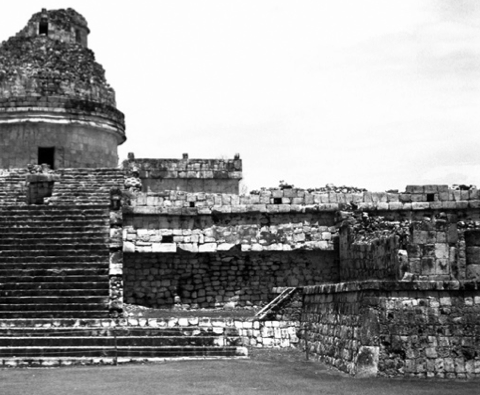Astronomers in Mexico
Doing Science from Scratch

A Mayan observatory is part of the Chichén Itzá pyramid complex in Yucatan, Mexico. The Mayan Indians were one of the first civilizations to explore the heavens.
Why astronomy? And why in Mexico? Science is an international effort. Newton’s law of gravitation does not have nationality, says the philosopher. In actuality, however, nationality does count. For the last few decades, Mexican astronomers have struggled to make a mark in the international field, with reasonable success. Astronomy in Mexico—as in many other parts of the less industrialized world—has waged an uphill battle against economic downturns, technical backwardness and whimsical politics, but it has been worth the effort.
A Lost History
Astronomical practice in Mexico has followed the rise and fall of civilizations. Before the European immigration, all major civilizations in what is now Mexico and northern Central America were well versed in matters of astronomy to keep a record of time for religious purposes and agricultural needs. Scholars know about the ability of Mayas, Aztecs and other peoples to predict eclipses, planetary positions, and moon phases, as proven for posterity by the alignment of their monuments with significant positions of the sun, the planets and the stars along the year.
Astronomy has had the need of mathematics for much longer than any other science. The Mayas had the inspiration to invent a positional numeral system similar to the one in use today. They also invented the conceptually difficult sign of nothingness, the zero. Positional numeral systems make for easy addition and subtraction and practical recording of arbitrarily large numbers. The Mayan system could record dates spanning 5,000 years. When Columbus stumbled upon the Americas, interest in gazing up the heavens had faded quite considerably in Europe. Europeans also showed little interest in keeping written native records when they torched big piles of Aztec and Mayan documents as satanic texts. The Dresden codex is one of a few Mayan books that survived the religious burning, although it did not fare as well during the Dresden fire bombings in World War II when it was water-damaged and partially destroyed. The Dresden codex records with remarkable accuracy the positions of Venus, Mars, and eclipse dates. A few other codices and fire-proof stone steles are what remains of written astronomical records in ancient Mexico.
Astronomy sank into near oblivion in official circles in Mexico until 1874, when an expedition of astronomy enthusiasts was sent to Japan to observe Venus as it passed directly between the sun and earth. Such an event, called a transit, happens in intervals of 8, 105 or 121 years.
Collaborating with astronomers from other countries to observe the Venus transits of 1874 and 1882 would prove important for Mexican astronomy in the coming decades. In 1887 an international astronomical congress met in Paris to propose to photograph the entire sky and record the positions of nearly 10 million stars by observatories around the globe. Mexico was among the 18 countries invited to join in the project, which would come to be know as the Carte du Ciel or Chart of the Sky. It has been said that the Carte du Ciel was a failure because most countries did not complete the tedious and meticulous task in their assigned parts of the sky. For those who did their part, like Mexico, the project became a burden and may have hampered development in other areas of astronomy. Yet the Carte du Ciel has regained some importance. As stars move within our galaxy, their positions in the sky change slightly with time. By comparing their present positions with those recorded in a distant past, it is possible to determine their motion in time across our galaxy, and here older catalogs like theCarte du Ciel are the key. Recently the Hipparcos satellite, launched by the European Space Agency in 1989, photographed the 2.5 million brightest stars in the entire sky to compare their positions with those recorded by the hundreds of men and women around the world who worked diligently in the Carte du Ciel project.
Astronomy in Mexico has always been close to the sphere of political power by chance or by need. During its early years, the National Astronomical Observatory (OAN) was supported both financially and physically by the government. Placed on top of several landmark buildings in Mexico City such as the National Palace and Chapultepec Castle, the observatory had to survive a revolution and government officials who reluctantly allocated meager budgets to people that preferred to look at the stars rather than worry about the earthly needs of a country in the throes of social unrest and armed rebellions. The observatory passed to the administration of the National Autonomous University of Mexico (UNAM) in 1929.
Between Nationalism And International Cooperation
The Mexican revolution produced a wave of nationalistic politicians after it ended in 1917. One of them, Luis Enrique Erro, had an interest in astronomy. Together with Harlow Shapley, director of the Harvard College Observatory and a prominent astronomer, Erro started a project to move Mexican astronomy from just measuring and recording star positions to the new field of astrophysics. Although largely a synonym of astronomy today, the term “astrophysics” was coined in the early 20th century to stress the application of the laws of physics to understand the universe. Why and for how long do stars shine, what are they made of, how do they form, why is the universe expanding? were some of the questions that astrophysics was trying to answer when Erro met Shapley while on diplomatic duty in the United States in 1939.
Mexican astrophysics required modern instruments and new observing techniques, but Mexico’s relations with the United States were at a low point because of the 1938 Mexican nationalization of U.S. and European oil companies, although overshadowed by U.S. concern about growing fascism in Europe. The Mexican government had no sympathy for fascism: Mexico and the USSR had been the only countries to give military aid to the Republican Spanish government against Franco, Hitler, and Mussolini, but a boycott by vengeful U.S. and British oil companies forced the Mexican government to seek technical aid from the Axis powers. Shapley, along with other Harvard astronomers like Bart Bok, had a keen eye for both astrophysics and politics, and soon an effort by the Harvard College Observatory and the U.S. government was under way to build a telescope for Mexico to win over its government during the war effort. In the middle of war preparations in the United States, President Roosevelt ordered to waive restrictions on the use of strategic materials, like high-quality aluminum, to build the Mexican telescope in record time at the Harvard Observatory shops in 1941. The telescope—the largest of its kind at the time—was dedicated in Tonantzintla, Puebla, a few weeks after the Pearl Harbor attack, and shortly thereafter Mexico declared war on the Axis powers.
While telescope diplomacy was moving ahead in Tonantzintla, one name entered Mexican astronomy to stay. Guillermo Haro had no college-level qualifications in physics or mathematics; he was a journalist when he interviewed Bart Bok in Mexico in 1941. Haro had instantly fallen in love with astronomy, and spent close to a year learning observational techniques at the Harvard College Observatory. He became the most famous Mexican astronomer because of his discoveries using the Tonantzintla telescope between 1949 and 1959.
In 1950 he discovered his most famous objects. George Herbig from Lick Observatory, CA, also discovered the same objects, a year later, but published the finding before Haro did. Herbig-Haro objects, or HH objects, as we prefer to call them, are peculiar clouds of hot gas in space. There is a lot of gas between stars, generically called interstellar matter. Most interstellar matter is cold in astronomical jargon, which means around 400ºF below zero in earthly terms. A luminous star can heat nearby interstellar matter to tens of thousands of degrees, and turn it into a plasma. A plasma is a state of matter where atoms become electrically charged. Plasmas on earth are often found in situations and places too hot or violent for human comfort, like nuclear blasts, rocket exhausts, lightning, some fires, but also neon signs and lately plasma TVs. The reader will notice that plasmas tend to produce fancy displays of light, and so do interstellar plasmas.
HH objects became an instant puzzle for astronomers because they were hot plasmas mixed with normal gas of the type usually found in the cold interstellar matter. To add to the puzzle, no nearby luminous star was seen to produce and heat the plasma.
One piece of the HH puzzle is the star that makes the effect happen. Stars are born in cold clouds by collapse. Gas in space tends to spread apart, but if the gas is dense enough, its force of gravity can overcome the tendency of the gas to spread, and the gas collapses into a ball of matter. As more matter falls onto the ball, its center heats up under the weight of the outer layers. Eventually nuclear reactions start up at the center, and a star is born. The newborn star remains surrounded by matter that did not fall onto the star. That matter blocks visible light, but there are other kinds of light that make it perceptible. Infrared light and radio waves can traverse more interstellar matter than visible light and reach earth, and the matter surrounding newborn stars produces bright infrared light and radio waves. Therefore the location of the star producing the HH object can be pinpointed by using telescopes that can detect infrared light and radio waves.
Before the 1930s most telescopes were built to record visible light, which is the kind of light our eyes sense. But much of the radiation of sky objects comes in radio waves. Astronomers use dishes similiar to the old parabolic satellite television dishes to observe radio waves from the universe, but their dishes—called radio telescopes—are much bigger than the home versions. Instead of having a TV at the end of the electronic circuitry, a radio telescope sends its signals to a computer that eventually prints images on paper of the objects observed by the radio telescope. Mexican astronomers have been especially successful with radio telescopes, not only in observing HH objects but also finding a wide variety of objects in the Universe.
Just as ancient Mayas needed a fast system of computation, Mexican astronomers today have been spearheading computer projects with a series of “firsts” in Mexico, for many reasons. Anxious to retrieve data from telescopes through the Internet, astronomers in Mexico made special efforts to install computer networks and fast Internet connections in the 1980s. However, government officials were reluctant to open satellite Internet connections at a time when the peso was nose-diving in the middle of an economic slump due to falling oil prices and a stock market crash. However, heavenly help came in the form of a supernova explosion in 1987 in the Large Magellanic Cloud, a satellite galaxy of our own Milky Way Galaxy, visible only from the southern hemisphere.
Witnessing a supernova is an event that nobody wants to miss, but a supernova is as unpredictable as spectacular. One theory holds that when a star runs out of nuclear energy at its center, it collapses under its own weight. The implosion of a star tens of times more massive than the sun can generate enough energy to produce a rebound of the inward-falling layers and blow the star apart. From earth all we see is a brightening star. It is not yet possible to know in advance when a star will turn into a supernova. The last supernova exploded in our galaxy in 1604. Every year astronomers observe a few supernovæ in other galaxies, but having a supernova in the neighborhood sent U.S. astronomers scrambling for real-time connection with observatories in South America, where all available telescopes were aimed at the exploding star. Mexico happened to be one place where an intermediate link could be installed to make that connection. Thus Mexican officials took a more positive attitude, and a satellite internet connection with other observatories and universities around the world was established in Mexico at the UNAM Institute of Astronomy in 1989, after passing countless bureaucratic hurdles. The astronomer in charge of the project said that if she had known that everything had to start from scratch, she would have quit. Today commercial internet lines link Mexican universities and observatories with the rest of the world.
Some astronomers do not observe through telescopes but prefer to hypothesize about objects observed by other astronomers. For those theoretical astronomers, computers are also an important tool, if not the only one, to simulate how the universe works. By describing mathematically assumptions about how matter must behave under certain conditions in space, an astronomer can program a computer to calculate what should happen at different places and times in the universe. Today astronomers in Mexico use a number of high-speed computers to test hypotheses and theories about the universe.
Haro had another telescope built in Tonantzintla in 1961. Eventually the Tonantzintla observatory and its two main telescopes were split between the UNAM Institute of Astronomy in Mexico City—the heir of the old OAN—and the Institute of Astrophysics, Optics and Electronics (INAOE), created in 1976 in Tonantzintla. During the following decades UNAM and INAOE have competed tightly for government funding to build larger telescopes. Astronomical observation in Tonantzintla was ruthlessly quashed when lights from the city of Puebla lit its night sky and rendered any attempt to see dim sky objects hopeless. But Mexico still has one of the three best sites for astronomical observation on earth on the San Pedro Martir Sierra, Baja California. At 9,200 feet above sea level and far from city lights, the OAN has reincarnated in San Pedro Martir with new telescopes—largely built in Mexico.
INAOE for its part has been building a giant radio telescope on Sierra Negra volcano in Puebla in collaboration with the University of Massachusetts at Amherst—the most ambitious Mexican science project to date. The technical challenges to build a 50 meter wide radio telescope are tremendous. When INAOE’s radio telescope starts gathering data, hopefully soon, it will be observing planets in our solar system, and galaxies at the limits of the universe.
In 1996 a group of adventurous astronomers from the UNAM Institute of Astronomy started the Center for Radio Astronomy and Astrophysics (CRyA) at UNAM’s Morelia campus in Michoacan. Moving from Mexico City to Morelia was a new start for Mexican astronomy.
CRyA has become a partner on equal footing with institutions in the United States, Canada, Europe and Japan that are building the Atacama Large Millimeter Array—an array of 64 radio telescopes in Chile—and two other arrays of radio telescopes through the United States and the Caribbean. Mexico got a foot in those projects by contributing instruments to detect the signals from the radio telescopes. Once finished, those radio telescope arrays will be able to make detailed images of objects like star- forming regions, and galaxies, and even search for planets around other stars.
Today, close to 200 astronomers work in Mexico, investigating virtually every topic in astronomy. Like other pure sciences, astronomy depends heavily on government funding in Mexico, but there is a catch. Mexican astronomers have to start from scratch most of the time, training technicians in electronics, mechanics and optics, and hoping that they will not migrate with their skills to more lucrative jobs in private companies. It also means fighting government bureaucracy and red tape, not to mention the eternal question government officials often ask: “Why do we need astronomy in Mexico?”
In May, 2004, TV news programs aired a video taken by the Mexican Air Force, showing alleged UFOs flying along their aircraft. The video took public attention away from an unfolding diplomatic crisis with Cuba. The Air Force declined to give a copy of the video for analysis to the Institute of Astronomy, arguing it was a classified document. Mexican astronomers have been trying to wrestle the public stage from UFO hunters and other scams through popularization talks, media conferences and astronomy books and articles for the layman. Watching a government branch and the media take the side of the swindlers was not good news for astronomy.
The saga of Mexican astronomy has been dramatic enough to inspire the novel “La piel del cielo” (The Skin of the Sky) by renowned author and journalist Elena Poniatowska. Astronomy in Mexico has always been seen as a cultural enterprise against general ignorance as much as a mission to leave a mark in universal knowledge. It has been a polemic over nationalistic beliefs and international collaborations–building telescopes in Mexico or collaborating with observatories abroad. Erro and Haro might have had strong nationalistic views, but they jump-started modern Mexican astronomy with a U.S.-made telescope. Regardless of the outcome, science in a given place on Earth has been the reflection of those who did it. When Spanish conquistadores torched almost all native literature, they were showing contempt not only for native math and astronomy, but for the societies that produced them. But perhaps the best answer to the questions at the beginning of this article was given by more than 10,000 people who showed up at the star party held in the Tzintzuntzan archaeological site on the night of January 31, 2009, to kick off celebrations of the International Year of Astronomy. People patiently waited in line for hours in cold weather to peek through telescopes while overwhelmed astronomy graduate students from the UNAM Morelia campus tried to answer questions on planets, nebulae and galaxies from thousands of inquisitive people. That is why Mexico truly needs astronomy.
Spring 2009, Volume VIII, Number 3
Vladimir Escalante-Ramírez is an astronomer at CRyA at the UNAM campus in Morelia with an undergraduate degree in physics from UNAM and a Ph.D. in astronomy from Harvard University.
Related Articles
Editor’s Letter: The Sky Above, The Earth Below
When I first started working on this ReVista issue on Colombia, I thought of dedicating it to the memory of someone who had died. Murdered newspaper editor Guillermo Cano had been my entrée into Colombia when I won an Inter American Press Association fellowship in 1977. Others—journalist Penny Lernoux and photographer Richard Cross—had also committed much of their lives to Colombia, although their untimely deaths were …
Other Cities, Other Worlds
Author of a marvelous book that excavates the palimpsests of memories encrypted in the image-filled voids of Berlin, Andreas Huyssen extends his investigation of the urban imaginary in…
Dirty Secrets, Dirty War: The Exile of Editor Robert J. Cox
t may be argued that Dirty Secrets, Dirty War: The Exile of Editor Robert J. Cox should have been written three decades ago, most likely in 1981, when Cox was enjoying, as I do now, a Nieman fellowship…




